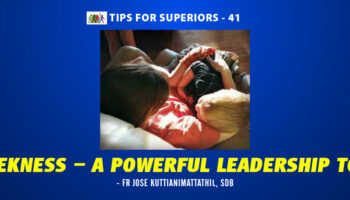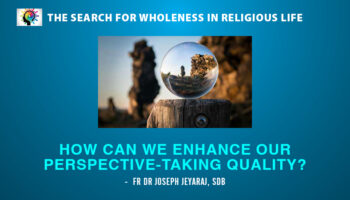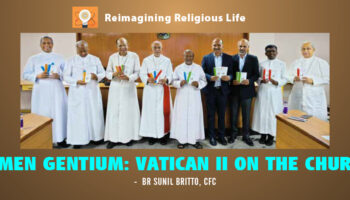A copy of MAGNET weighs about seventy grams. When we send copies in bulk, the post office checks the weight of the parcel. The meaning of grams or kilograms or pounds or inches is not a matter of opinion. We all know the meaning of a “kilo of sugar” or “three metres of cloth.”
Weights and measures serve a purpose. They are the norm for judging whether a shop sold me the right amount of sugar or the right length of material.
The norm of goodness and holiness, of fidelity and right living, for us, Christians, is Jesus. Holiness is imitation of Christ. A saint is someone who is Christ-like.
Jesus is exemplar, norm, model, Lord, brother, friend.
We do not join a religious order to follow Francis or Ignatius, Teresa or Don Bosco, but to follow Jesus. If being a Franciscan or Carmelite helps me to become more like Jesus, being a part of that group makes sense; if not, I should quit and seek my goal elsewhere.
Who is Jesus? What did he teach? What did he do?
No other religion is so centred around one person as Christianity is. It is crucial for us to clarify how we see Jesus, understand his teachings and try to imitate him.
Here is my attempt to summarize what he did and said.
- Incarnation: This unusual word means: He chose to become one of us. Didn’t want to keep a distance from us. Human beings matter much to God.
- Abba: Jesus’ life focus was Someone he referred to as Abba (a term children used to refer to their father). More than union, they had a relationships of oneness. He spoke to this Abba even in the midst of excruciating pain when he felt totally abandoned.
- Power: This oneness with Abba gave him unmatched power. This power is very different from that of the movie hero who beats up the villain. Jesus used his divine power only to do good. Of the thirty-seven miracles recorded in the Gospels, most are healings. Others are caring gestures, like turning water into wine or calming the stormy sea. He never used his power to put down anyone, or to crush an enemy. This is a sharp contrast between the Gospels and the mythologies of major religions.
- Prayer: He spent nights in prayer. Why on earth did God’s Son have to do it?
- Temptations: Stranger still, he was tempted in the ways that all humans are—by power, pleasure and possessions.
- Compassion, not condemnation: Look at the incident of the woman caught in adultery, or Jesus’ dealing with Peter after the betrayal, or his stories about the lost sheep, or the prodigal son or the lost coin. God reaches out to the lost with greater concern.
- Company of the Least: He mostly mixed with ordinary folk, and the unwanted and the despised. He did not cultivate the circle of VIPs, nor seek privileges.
- Kind and tough: He was kind to the weak and tough with the powerful. He would touch the blind, the sick, the leprosy patient. He challenged the hypocrisy and cruel indifference of those on top.
- People more than ritual: For him, evidently, people mattered more than the temple or the Sabbath—something that upset the orthodox a great deal. He moved, as Scripture scholars tell us, from an ethic of cult to an ethic of relationships. We will one day be judged on how we treated the needy and shared our gifts, not on how “religious” we were.
- Love as core commandment: In fact, practically the only commandment was not a commandment, but an appeal from the heart of God: Learn to love! He gave this as the surest sign of discipleship. (Four centuries later, Augustine would summarize Christian ethics as “love and do whatever you wish.”
- Love without boundaries: We are to love as He did—without boundaries, without walls, without excluding anyone. Everyone matters for God, not just those of my place, or religion, or caste or tribe.
- Love as service of the least: Not limited to prayers and sweet words, but expressed in concrete good deeds, especially for the weakest.
- Love that forgives: One of the harshest statements in the Gospels is the condemnation of the servant who, after being forgiven a huge debt, does not forgive his fellow servant a tiny debt. His own example from the Cross is without parallel.
- Authority as service: The night before he died, he did something shocking, something that only slaves did in his culture—washing the feet of men who called him teacher and lord. Wouldn’t you be shocked if the bishop were to turn up at your house and start sweeping the rooms and washing the toilets?
- Experienced weakness and need: He experienced fatigue, hunger, loneliness, fear, tears, extreme physical pain.
- Accepted help: The hospitality of good friends. The help of Simon of Cyrene on the way to Calvary. (God sends us help, but we have no right to insist that it should come from those from whom we expected it.)
- Childlike charm: Children didn’t find him boring, but were instead drawn to him. A kind and apparochable elder brother or uncle, not a solemn, distant preacher.
- Died an apparent failure: Humiliated, tortured beyond measure, abandoned by his so-called friends and followers.
- God’s tender face: He came among us showing us God’s tender face. He did not, in words or deeds, present a frightening or distant God, but an incredibly compassionate and tender God.
- Victory from failure: By his wounds, I am healed. Out of his apparent failure, God wrote His poem of victory. Transformed by Him, Peter would heal the cripple and Paul would say, “I can do all things through Christ, who strengthens me.” Jesus’ transforming power has touched, healed and transformed countless men and women down the ages. This miracle continues. May you and I be open to the same transforming encounter.
This is the Master we follow. This is the model to imitate. If there were better ways of saving the world and helping people, God would have chosen that.
This is my attempt to summarize what Jesus brought us. How would you summarize Jesus’s life and teachings? How do you find his example and teachings—impractical, hard, magnetic, life-giving?
Questions for Reflection/Prayer:
- Who is Jesus for me? What difference does He make in my Life? ………………………………………………………………………….. ………………………………………………………………………………………………………
- Who is God for me? What is my favorite image of God? ………………………….. ……………………………………………………………………………………………………
Who am I for God? …………………………………………………
3. How would I summarize the essentials of Jesus’ teaching (in simple, non-technical language, for myself, or for a young person today)?
- ……………………………………………………………………………………
- ……………………………………………………………………………………
- ………………………………………………………………………………….
- …………………………………………………………………………………..
- …………………………………………………………………………………..
4. Who are the most “Christ-like” persons I have known? Why do I call them Christ-like? In what ways were/are they like Jesus? …………………………………….. ………………………………………………………………………………………….. …………………………………………………………………………………………..
5. Over the years, do I find myself becoming more Christ-like or less so? …..
6. Why? ………………………………………………………………………………….. …………………………………………………………………………………………..
7. Is it my heart’s desire to become more like Jesus, or am I more interested in worldly success (power, money, possessions, fame, etc)? ………………………………… …………………………………………………………………………………………..
8. What is my definition of a meaningful (“successful”) life? …………………… …………………………………………………………………………………………..
9. What do I need to do to become more Christ-like? ………………………….…. ……………………………………………………………………………………………
Joe Mannath SDB
To subscribe to the magazine, click Subscribe





